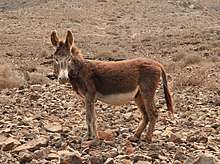Majorera donkey
The Majorera is an endangered breed of small domestic donkey indigenous to the Canary Islands, the Spanish archipelago in the Atlantic off the coast of southern Morocco. There are approximately 200 of the donkeys; almost all are on the island of Fuerteventura, with a small number on Lanzarote. The name derives from majorero, a demonym for the people of Fuerteventura.[7] The Majorera is a small donkey of African origin, and is the only equine breed of the archipelago.[6]:435
 In Pájara, Fuerteventura | |
| Conservation status | |
|---|---|
| Other names | |
| Country of origin | Spain |
| Distribution |
|
| Traits | |
| Weight | |
| Height | |
| Coat | grey in all shades, or brown[6]:435 |
| Classification | |
| Consejería de Agricultura, Ganadería, Pesca y Aguas | Breed standard |
| |
History
The Majorera was introduced to the Canaries at the time of the Spanish conquest in the fifteenth century. It is now present in all six municipalities of Fuerteventura, Antigua, Betancuria, La Oliva, Pájara, Puerto del Rosario and Tuineje; a small number are on Lanzarote, and a few on the other islands.[6]:436
From 1997 the Majorera was listed by the Ministerio de Agricultura, Alimentación y Medio Ambiente, the Spanish ministry of agriculture, as "under special protection, in danger of extinction".[6]:435 Its conservation status was listed as "critical" by the FAO in 2007[1]:108 and as "endangered" by the SAVE Foundation in 2008.[2]:46
The breed is well adapted to the volcanic semi-desert conditions, the high temperatures, and the low rainfall of Fuerteventura, and was used by the islanders for riding and for all kinds of agricultural work: as a pack animal, as a draught animal, and for animal traction tasks such as ploughing.[4][6] As with other donkey breeds, the mechanisation of agriculture in the twentieth century led to a rapid fall in numbers. In 2009 the population was reported as 141; at the end of 2013 the total number recorded was 27.[4][8]
Characteristics
The Majorera is a small donkey of African type. It usually grey, ranging from pale to dark grey, and may also be brown. It has primitive markings: a darker dorsal stripe and shoulder-stripe, and zebra-striping on the legs.[3] It stands about 1.00–1.20 metres at the withers, and weighs about 125–175 kilograms.[6]:437
References
- Barbara Rischkowsky, D. Pilling (eds.) (2007). List of breeds documented in the Global Databank for Animal Genetic Resources, annex to The State of the World's Animal Genetic Resources for Food and Agriculture. Rome: Food and Agriculture Organization of the United Nations. ISBN 9789251057629. Accessed July 2014.
- Waltraud Kugler, Hans-Peter Grunenfelder, Elli Broxham (2008). Donkey Breeds in Europe: Inventory, Description, Need for Action, Conservation; Report 2007/2008. St. Gallen, Switzerland: Monitoring Institute for Rare Breeds and Seeds in Europe. Archived 2 September 2009.
- ORDEN de 5 de agosto de 2014, por la que se aprueban las reglamentaciones específicas de los libros genealógicos de las razas autóctonas canarias de las especies caprina, ovina, bovina, porcina y asnal (in Spanish). Consejería de Agricultura, Ganadería, Pesca y Aguas. Boletín Oficial de Canarias 158 (18 August 2014): 22849–22930. Accessed February 2020.
- Breed data sheet: Majorera/Spain. Domestic Animal Diversity Information System of the Food and Agriculture Organization of the United Nations. Accessed July 2014.
- Raza equino asnal Majorera: Datos Morfológicos (in Spanish). Ministerio de Agricultura, Alimentación y Medio Ambiente. Accessed February 2020.
- Miguel Fernández Rodríguez, Mariano Gómez Fernández, Juan Vicente Delgado Bermejo, Silvia Adán Belmonte, Miguel Jiménez Cabras (eds.) (2009). Guía de campo de las razas autóctonas españolas (in Spanish). Madrid: Ministerio de Medio Ambiente y Medio Rural y Marino. ISBN 9788449109461.
- Raza equino asnal Majorera: Datos Generales (in Spanish). Ministerio de Agricultura, Alimentación y Medio Ambiente. Accessed February 2020.
- Raza equino asnal Majorera: Datos Censales (in Spanish). Ministerio de Agricultura, Alimentación y Medio Ambiente. Accessed July 2014.